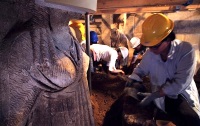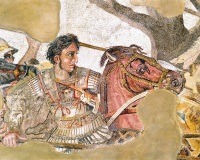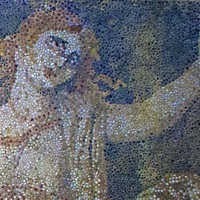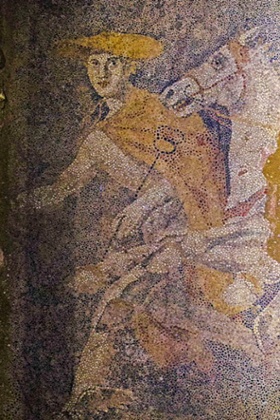Human Representations Found in Amphipolis Tomb Epistyle
- Details
- Published: Saturday, 29 November 2014 17:06
 The Greek minister visited the Casta hill excavation site today to see the new findings and to be briefed on the progress of the project. A press conference followed the minister’s briefing, where Mr. Tasoulas said that “Amphipolis is an exercise in wonderment and patience.
The Greek minister visited the Casta hill excavation site today to see the new findings and to be briefed on the progress of the project. A press conference followed the minister’s briefing, where Mr. Tasoulas said that “Amphipolis is an exercise in wonderment and patience.
National Geographic: Behind Tomb Connected to Alexander the Great, Intrigue Worthy of "Game of Thrones"
- Details
- Published: Monday, 24 November 2014 14:29
 Suspense is rising as archaeologists sift for clues to the identity of the person buried with pomp and circumstance in the mysterious Amphipolis tomb in what is now northern Greece. The research team thinks the tomb was built for someone very close to Alexander the Great—his mother, Olympias; one of his wives, Roxane; one of his favorite generals; or possibly his childhood friend and lover, Hephaestion.
Suspense is rising as archaeologists sift for clues to the identity of the person buried with pomp and circumstance in the mysterious Amphipolis tomb in what is now northern Greece. The research team thinks the tomb was built for someone very close to Alexander the Great—his mother, Olympias; one of his wives, Roxane; one of his favorite generals; or possibly his childhood friend and lover, Hephaestion.
BBC: Greece archaeologists uncover Amphipolis floor mosaic
- Details
- Published: Tuesday, 21 October 2014 22:34
 Archaeologists unearthing a huge ancient burial site at Amphipolis in northern Greece have uncovered a large floor mosaic.
Archaeologists unearthing a huge ancient burial site at Amphipolis in northern Greece have uncovered a large floor mosaic.
The mosaic - 3m (10ft) wide and 4.5m (15ft) long - depicts a man with a laurel wreath driving a chariot drawn by horses and led by the god Hermes.
The burial site is said to be the largest ever found in Greece.
It dates from the late 4th Century BC, spurring speculation that it is linked to Alexander the Great of Macedon.
Archaeologists started digging in August and think the magnificence of the tomb means it was built for someone very important.
CNN: Greece hopes tomb discovery breathes life into economy
- Details
- Published: Tuesday, 21 October 2014 22:26
Athens, Greece (CNN) -- An imposing ancient floor mosaic depicting a man driving a chariot drawn by horses and led by the Greek messenger god Hermes is the latest in a series of remarkable finds archaeologists have unearthed in the largest ancient tomb found in Greece, at Amphipolis in the country's north.
National Geographic: Who's Buried in Largest Tomb in Northern Greece?
- Details
- Published: Monday, 20 October 2014 22:50
 Archaeologists excavating a massive burial mound in northern Greece have uncovered this female figurine, one of a pair sculpted from marble.
Archaeologists excavating a massive burial mound in northern Greece have uncovered this female figurine, one of a pair sculpted from marble.
Dating to the tumultuous years surrounding the death of Alexander the Great, between about 325 and 300 B.C., the tomb is the largest ever found in northern Greece—a resting place monumental enough for royalty.
The burial borders the ancient Aegean port of Amphipolis (near modern-day Amfípoli), which once served as the base for the fleet that Alexander the Great took on his invasion of Asia.
Fans of ancient history are laying bets on who was buried in the dark heart of a massive marble-walled tomb that is slowly coming to light in northern Greece.
The Guardian: Mosaic uncovered in northern Greece could mark royal Macedonian tomb
- Details
- Published: Monday, 20 October 2014 22:44
Archaeologists excavating Amphipolis site have discovered an intricate, and largely intact, floor mosaic dating back to 300BC
 The mosaic found at the mysterious Alexander The Great-era tomb near Amphipolis in the Macedonian region of northern Greece. Photograph: Handout/AFP/Getty
The mosaic found at the mysterious Alexander The Great-era tomb near Amphipolis in the Macedonian region of northern Greece. Photograph: Handout/AFP/Getty
Two days after bones found in northern Greece were confirmed to be those of Alexander the Great’s father, archaeologists excavating a vast ancient tomb in Amphipolis have uncovered an intricate floor mosaic that could signal another royal Macedonian grave.
The mosaic, measuring three metres by 4.5 metres wide, depicts a horseman with a laurel wreath driving a chariot and two horses after Hermes, the Greek god of travel and guide to the underworld.